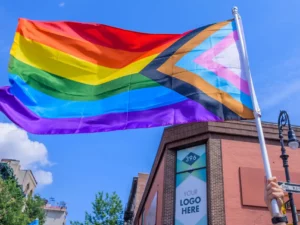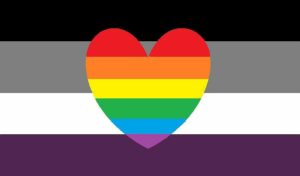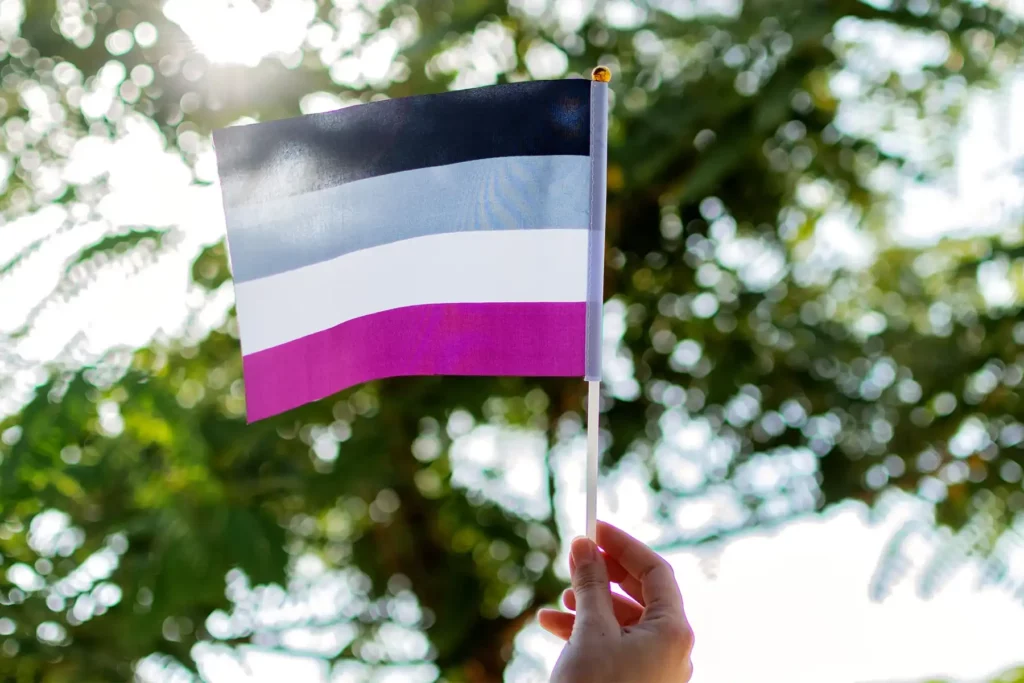While the rainbow flag is a well-recognized symbol of the broader LGBTQ+ community, many may not know about the equally important asexual flag. This flag represents those who identify as asexual, embodying a distinct spectrum within the realm of human sexuality. In this article, we delve into the meaning, history, and significance of the asexual flag, serving as a guide for understanding and appreciating this unique symbol of identity.
Contents
What Does Asexual Flag Mean?
 The asexual flag serves as a symbol of pride, identity, and unity for individuals who identify as asexual. This means they do not experience sexual attraction. The flag’s design, comprised of four horizontal stripes in black, grey, white, and purple, respectively, encapsulates the broad spectrum of asexuality. The black stripe represents asexuality itself, while the grey stripe signifies gray asexuality and demisexuality, acknowledging those who experience sexual attraction infrequently or only under specific circumstances.
The asexual flag serves as a symbol of pride, identity, and unity for individuals who identify as asexual. This means they do not experience sexual attraction. The flag’s design, comprised of four horizontal stripes in black, grey, white, and purple, respectively, encapsulates the broad spectrum of asexuality. The black stripe represents asexuality itself, while the grey stripe signifies gray asexuality and demisexuality, acknowledging those who experience sexual attraction infrequently or only under specific circumstances.
The white stripe stands for sexuality, recognizing non-asexual identities and emphasizing the spectrum of human sexuality. Lastly, the purple stripe symbolizes the community, denoting the shared experiences and unity among diverse identities within the asexual community. Collectively, the asexual flag is a visual testament to the inclusivity, diversity, and strength of the asexual community.
What Is The Symbolism And Meaning Behind Each Stripe?
The asexual flag consists of four stripes, each with its unique color and symbolism that together represent the diversity and unity of the asexual community.
- Black Stripe: Asexuality
The black stripe at the top of the flag symbolizes asexuality. It signifies individuals who do not experience sexual attraction. The color black was chosen as it is generally associated with the absence of something, in this case, the absence of sexual attraction.
- Grey Stripe: Gray-Asexuality and Demisexuality
The grey stripe, next to the black, represents gray asexuality and demisexuality. Gray asexuals may experience sexual attraction occasionally, under specific conditions, or at a lower intensity than others. Demisexuals, on the other hand, only experience sexual attraction after forming a strong emotional bond with someone. The color grey was chosen to represent this area, as grey often symbolizes ambiguity or being ‘in between’ black and white.
- White Stripe: Sexuality
The third stripe is white, signifying sexuality. It stands for those who fall under the sexual spectrum, recognizing and respecting their place alongside asexual identities. The white stripe acknowledges the broader spectrum of human sexuality and the importance of understanding asexuality in relation to it.
- Purple Stripe: Community
The bottom stripe of the flag is purple, symbolizing community. This color represents the unity, solidarity, and shared experiences of individuals within the asexual community, despite the diversity of identities it encompasses.
The asexual flag, therefore, in its design and color symbolism, acknowledges and honors a broad range of identities and experiences within the asexual community.
Evolution and Acceptance of the Asexual Flag Over Time
 The asexual flag, while not as old as some other flags within the LGBTQ+ community, has nevertheless undergone a significant journey since its inception. And reflecting the evolving understanding and acceptance of asexuality.
The asexual flag, while not as old as some other flags within the LGBTQ+ community, has nevertheless undergone a significant journey since its inception. And reflecting the evolving understanding and acceptance of asexuality.
The concept of asexuality started gaining more visibility in the late 20th and early 21st centuries. But it wasn’t until 2010 that the asexual community got its official flag. Prior to this, there wasn’t a universally recognized symbol to represent asexuality. The asexual flag’s acceptance has mirrored the growing recognition of asexuality itself. Initially, understanding and acceptance were limited, partly due to a lack of awareness and prevalent misconceptions about asexuality.
However, as dialogue around asexuality has increased, so too has a recognition of the flag. The flag has played a vital role in this process, serving as a rallying symbol for asexual individuals and a tool for increasing visibility and awareness.
Today, the asexual flag is recognized within the broader LGBTQ+ community and beyond. It’s regularly seen at Pride events and is also increasingly appearing in media and popular culture. While progress has been made, work continues to ensure asexuality. And the flag is recognized and respected worldwide.
Myths And Misconceptions About Asexual Flag
While understanding and acceptance of the asexual flag and what it represents have been growing, several myths and misconceptions still persist, partly due to limited knowledge and understanding of asexuality. Here are some common myths and the facts that debunk them:
- Myth: Asexuality, and by extension the asexual flag, represents a lack of sexuality.
Fact: Asexuality, symbolized by the black stripe in the flag, doesn’t signify an absence of sexuality but rather refers to individuals who do not experience sexual attraction. It’s an integral part of the spectrum of human sexuality.
- Myth: The asexual flag only represents asexual people.
Fact: This flag represents a spectrum of identities. The grey stripe symbolizes graysexual and demisexual individuals, and the white stripe acknowledges non-asexual identities.
- Myth: The asexual flag is a symbol of celibacy or abstinence.
Fact: This flag represents asexuality, not actions or choices like celibacy or abstinence. While some asexual people may choose to abstain from sex, asexuality is about one’s innate sexual orientation and not about choices related to sexual behavior.
- Myth: The asexual flag is less important or less valid than other LGBTQ+ flags.
Fact: The asexual flag is just as valid and important as other LGBTQ+ flags. It represents a unique aspect of the LGBTQ+ community and is a symbol of identity, pride, and unity for asexual individuals and allies.
By debunking these myths and promoting accurate information about this flag and asexuality, we can contribute to a more inclusive and understanding environment for everyone within the LGBTQ+ community.
How To Appreciate And Support Asexual Flag?
 Appreciating and supporting the asexual flag involves more than merely recognizing it as a symbol. In fact, it requires understanding, respect, and active allyship for the asexual community. Here are a few ways to do so:
Appreciating and supporting the asexual flag involves more than merely recognizing it as a symbol. In fact, it requires understanding, respect, and active allyship for the asexual community. Here are a few ways to do so:
- Educate Yourself and Others
Learning about the asexual flag, its colors, what it represents, and the diversity within the asexual spectrum is a significant first step. Share your knowledge with others to dispel myths and misconceptions about asexuality.
- Acknowledge and Respect the Flag
Treat the flag with the same respect and acknowledgment as other LGBTQ+ flags. This includes representing it accurately and understanding its significance.
- Advocate for Inclusion
Ensure that the asexual flag and community are included in discussions about LGBTQ+ rights, Pride events, and other relevant contexts. Speak up if you notice they are being overlooked or misrepresented.
- Support Asexual Individuals
Be respectful and supportive of individuals who identify as asexual. Affirm their experiences and identities, and make it clear that you’re a safe person to talk to about asexuality.
- Promote Visibility
Share images of this flag on your social media platforms, particularly during Pride Month or Asexuality Awareness Week, to raise awareness and show support for the asexual community.
- Listen and Learn from Asexual Voices
Pay attention to the experiences and insights of asexual people. They are the experts on their own identities, so take the time to listen and learn from them.
By adopting these practices, you can appreciate and support this flag, contributing to a more inclusive and accepting environment for the asexual community.
Conclusion
In conclusion, the asexual flag stands as a powerful symbol of identity, unity, and pride within the asexual community. Its unique color scheme encapsulates the diverse experiences on the asexual spectrum, celebrating asexuality while acknowledging gray sexuality, demisexuality, sexuality, and the overarching sense of community.
The flag’s evolution and growing acceptance over the years mirrors the increased awareness and understanding of asexuality, demonstrating a significant shift towards inclusivity within society. Let us continue to honor and uphold the asexual flag’s significance, understanding that every stripe weaves into the narrative of human diversity. Ultimately, making our societal fabric richer and more vibrant.
Life may sometimes be challenging for asexuals, but Online Asexual Counseling can help. Get experienced LGBTQ therapists at PrideMantra: Book a trial LGBTQ therapy session


